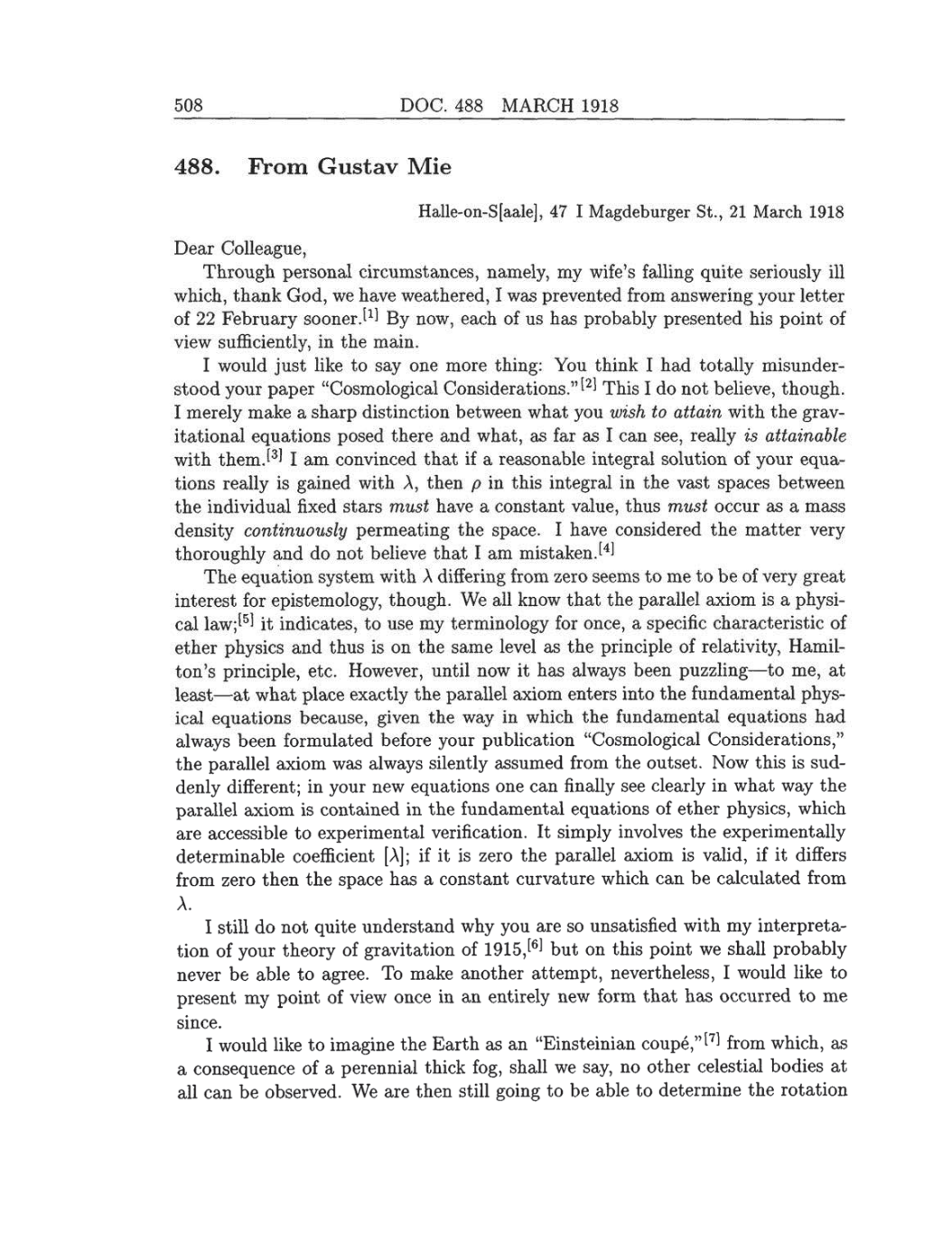508
DOC.
488
MARCH
1918
488. From
Gustav
Mie
Halle-on-S[aale],
47
I
Magdeburger St., 21
March
1918
Dear
Colleague,
Through
personal circumstances, namely, my
wife’s
falling
quite
seriously
ill
which,
thank
God,
we
have
weathered,
I
was
prevented
from
answering your
letter
of
22 February sooner.[1]
By
now,
each of
us
has
probably presented
his
point
of
view
sufficiently,
in the main.
I would just like
to
say
one more thing:
You
think
I
had
totally
misunder-
stood
your paper “Cosmological
Considerations.”[2] This
I
do not
believe,
though.
I
merely
make
a
sharp
distinction
between
what
you
wish
to
attain
with the
grav-
itational
equations posed
there
and
what,
as
far
as
I
can see, really
is attainable
with
them.[3]
I
am
convinced
that
if
a
reasonable
integral
solution of
your equa-
tions
really
is
gained
with
A,
then
p
in
this
integral
in
the
vast
spaces
between
the individual
fixed
stars must have
a
constant
value,
thus
must
occur as a mass
density continuously
permeating
the
space.
I
have considered
the
matter
very
thoroughly
and do not
believe
that
I
am
mistaken.[4]
The
equation
system
with
A
differing
from
zero
seems
to
me
to be
of
very
great
interest for
epistemology, though.
We
all know
that
the
parallel
axiom
is
a
physi-
cal
law;[5]
it
indicates,
to
use
my terminology
for
once,
a
specific
characteristic
of
ether
physics
and thus
is
on
the
same
level
as
the
principle
of
relativity,
Hamil-
ton’s
principle,
etc.
However,
until
now
it
has
always
been puzzling-to
me,
at
least-at
what
place
exactly
the
parallel
axiom enters
into the fundamental
phys-
ical
equations because,
given
the
way
in which the
fundamental
equations
had
always
been
formulated before
your publication “Cosmological Considerations,”
the
parallel
axiom
was
always
silently
assumed
from
the
outset.
Now
this
is
sud-
denly
different;
in
your
new
equations
one can
finally
see
clearly
in what
way
the
parallel
axiom
is
contained
in
the fundamental
equations
of
ether
physics,
which
are
accessible to
experimental
verification.
It
simply
involves
the
experimentally
determinable
coefficient
[A];
if
it
is
zero
the
parallel
axiom
is valid,
if
it
differs
from
zero
then the
space
has
a
constant curvature which
can
be
calculated
from
A.
I still do not
quite
understand
why you
are so
unsatisfied
with
my
interpreta-
tion of
your
theory of gravitation
of
1915,[6]
but
on
this
point
we
shall
probably
never
be able
to
agree.
To
make
another
attempt, nevertheless,
I
would like to
present my
point
of view
once
in
an
entirely
new
form
that has
occurred to
me
since.
I
would
like
to
imagine
the Earth
as an
“Einsteinian
coupé,”[7]
from
which,
as
a
consequence
of
a
perennial
thick
fog,
shall
we
say, no
other
celestial bodies
at
all
can
be observed.
We
are
then
still
going
to
be able to determine
the rotation
